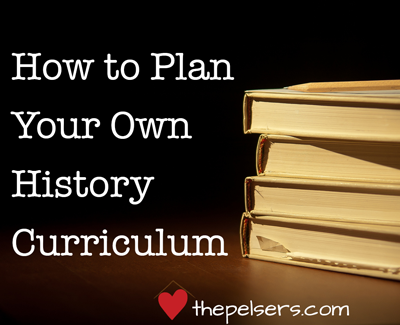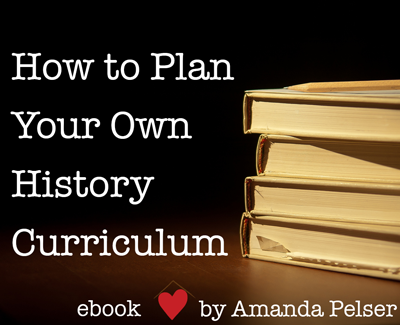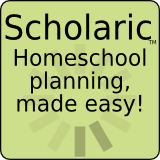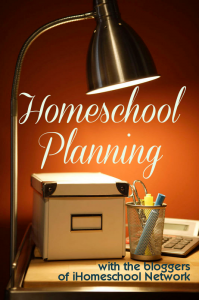After using a boxed curriculum and constantly jumping off the schedule, I decided it was time to rethink my approach for history and literature. The thought of planning my own history curriculum seemed daunting, but the more I looked at it, I knew I needed to do it. You know what? It's not that hard to plan your own history curriculum. Really it's not. Keep reading and you'll see that you can plan your own history curriculum too.

How to Plan Your Own History Curriculum
Choose a time period.
History is often done in 4 year cycles: Ancient, Medieval, Reformation, and Modern. You need to first choose which period of history you're going to work on. It's best to start with ancient and work in order, but if you've been using a boxed history curriculum, you may prefer to start with the next period.
Choose a history spine.
Pick a good living history spine that will give you an overview of the time period you're studying. You want something that is not dry and boring. This is not supposed to be an uninteresting textbook. This should be a well-written and engaging big picture look at your time period. Two of the most commonly used history spines are:
We've been using Story of the World Volume 1 for our ancient history studies. It's enjoyable for me as the teacher to read and Jonathan enjoys the stories. Note that there are extra activity books and options that are available for these spines. They are not “required” but you may find them helpful. We have been using the activity guide for Story of the World Volume 1, but we don't do every activity suggested. Just do what your kids would enjoy and best reinforce the material for their learning style.
Choose an encyclopedia.
It's helpful to have an encyclopedia to help fill in the details, give more information about particular people or events, and to look up information that may not be covered in your history spine. Here are a few helpful encyclopedias to consider:
Choose read-alouds and readers.
This step is probably the most daunting part of the whole process. There are a number of great resources for finding great read-alouds and readers for your chosen period of history. Don't feel like you have to cover everything, especially if this is your first time through the time period. If you start in 1st grade with ancient history and follow a Classical or Charlotte Mason model, your child will go through all of history three times. They'll go more in-depth and cover new things each time they cover a historical period.
- Sonlight
- Timeline of Classics
- Beautiful Feet Books
- Ambleside Online
- Story of the World Activity Books
- The Well-Trained Mind by Susan Wise-Bauer
- Read for the Heart by Sarah Clarkson
- Other homeschoolers
Make a schedule.
First, you'll want to match up your read-alouds and readers to the corresponding chapters in your chosen history spine.
Next, use your history spine as your guide. For example, Story of the World Volume 1 has 42 chapters. Depending on your yearly schedule, you'd need to cover about one chapter each week to finish in a 36 week, 180 day school year. Some weeks, you'd need to do 2 chapters.
Once you see how the spine schedules out, add in your read-alouds and readers. You may need more than one week to finish these books depending on their length. You likely won't have read-alouds and readers that correspond with each chapter so just plan to keep reading while moving on to the next chapter in your spine.
Now that you know what needs to be accomplished each week, spread it out across the week. Do you do history every day? Two or three days each week? Determine what works best for the learning styles of your kid(s) and spread out the work in a way that works best for them.
Here's where my favorite planning software comes in: Scholaric Homeschool Planner. It's like a paper planner, but much easier to move things around. No scribbles or white-out needed! Plus it's created by a homeschool dad who understands the struggles of lesson planning.
When I plan with Scholaric, I first put in anticipated breaks and days off. Then I can put in the spine readings using reoccurring lessons. After that, I add the read-alouds and readers to match up with the spine. If we get off, I can easily use the bump feature to move lessons forward or backward. I usually work in 6-18 week segments to make scheduling simple.
Here are some links to help you with scheduling in Scholaric:
- Video Tutorial
- Advanced Reoccurring Scheduling: example 1, example 2, example 3
- Printing Lesson Plans
Make a notebook/binder.
I'm a big fan of notebooking. It's a great way to reinforce what you've been reading about. For younger children, this may be coloring or drawing pages and maps while older children may be writing longer narrations or reports on what they've been learning. Here are some places to get notebooking pages and lapbooks:
Make a timeline.
Timelines are the best way to help your kid(s) understand where people, places, and events fit into history. You can buy timeline books or make one yourself and put it into the notebook you made. You can buy or print timeline figures, print pictures online, or simply draw and handwrite the dates and basic info in the proper place in time. Here are some timeline resources:
- Sonlight's Book of Time
- Printable Timeline
- Sonlight's Timeline Figures
- Confessions of a Homeschooler's Timeline Figures
eBook: How to Plan Your Own History Curriculum
To make this even easier, I've compiled all of this information along with some planning pages and additional printables. Click on the download button to get your copy. You CAN plan your own history curriculum!

That's it! Read, relax, and enjoy studying history.
Do you have a resource that you think should be added to these suggestions? Leave it in the comments for me.
Questions about planning your own history curriculum? Let's chat in the comments!
This post is sponsored by Scholaric Homeschool Planner and a part of the iHomeschool Network's Round Up of Planning Guides. This post contains affiliate links.
.png)


